Apartment hunting can be fun, but also a massive headache. Thankfully, technology is here to help. Instead of scouring through every neighborhood or apartment complex in your city to find a place that fits your budget to live on your own and needs, you can speed things up by using an apartment finder. The following list features some of the most popular free sites that allow you to search, compare, and virtually tour all kinds of rental properties, so you can narrow down your choices and find the one that’s right for you.
Overview of the best apartment websites
| Site | Best for | Search features |
|---|---|---|
| Padmapper | Picky renters | Type of building, number of bedrooms and bathrooms desired, listing age, square footage, whether a listing has online live tours. |
| Walk Score | Renters without a car | Price, bedrooms, pets allowed, photos included, commute, must have amenities, search by walk score, public transit routes. |
| Rent.com | Condo and townhome rentals | Price, type of housing, bedrooms and bathrooms, pets allowed, amenities, type of community. |
| Trulia | Neighborhood searches | Location, price, bedrooms and bathrooms, square footage, pets allowed, rental type, amenities, furnished housing, income restricted housing, keyword search. |
| Apartments.com | Largest number of listings | Price, bedroom number, rental type, lifestyle, move-in date, amenities, affordability, keywords. |
| Zumper | Those who travel a lot for work | Location, price, type of rental, number of bedrooms, furnished properties, pets allowed, whether a listing has photos, keyword search, move-in date. |
| Realtor.com | City rentals | Location, price, type of rental, number of bedrooms, number of bathrooms, pets allowed, whether a listing has photos, keyword search, unit and community amenities, unit features, move-in date. |
| HotPads | Side-by-side comparison | Location, price, type of rental, number of bedrooms, number of bathrooms, pets allowed, unit and community amenities, live-in features, commute distance, move-in date. |
| Zillow | Finding the best deal | Location, price, type of rental, number of bedrooms, number of bathrooms, pets allowed, unit and community amenities, housing size, historical pricing, live-in features, commute distance, move-in date. |
PadMapper
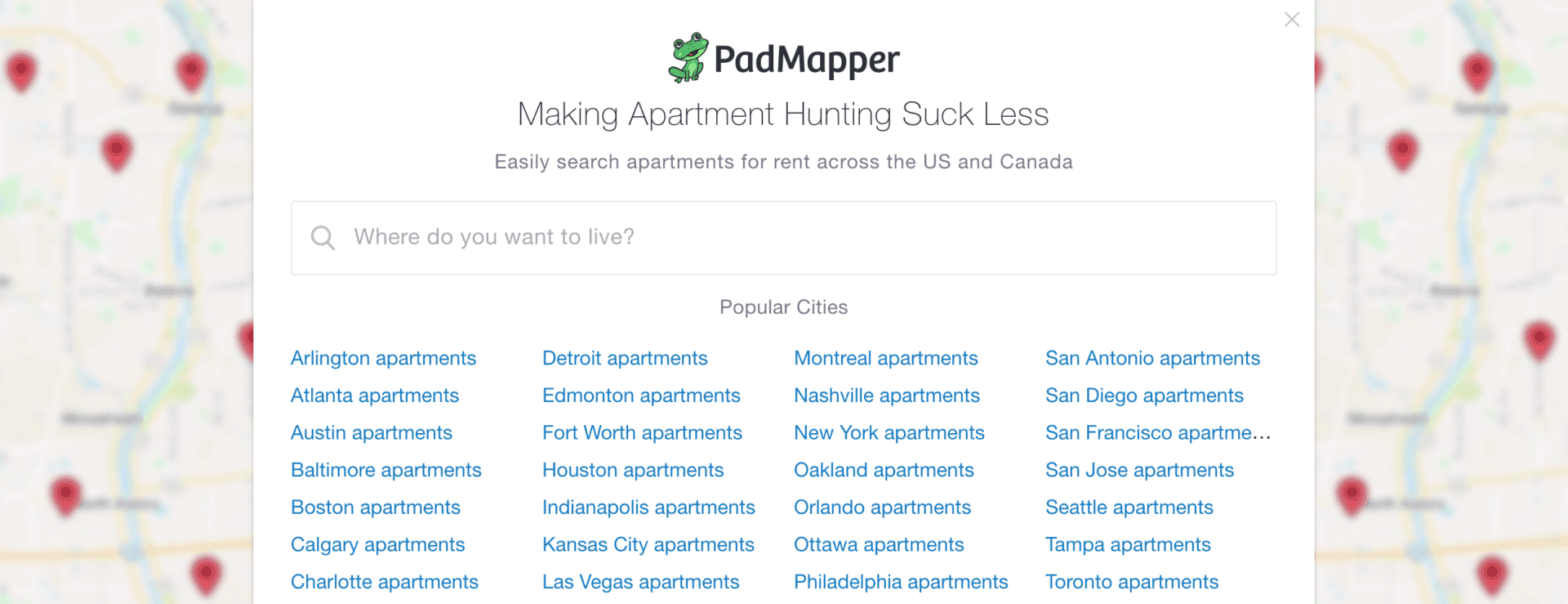
PadMapper is great for getting an immediate sense of what’s available in your chosen city, and also where those apartments are in relation to public transit, and possibly to your new office. It takes listings from other rental sites, including Craigslist, and maps them, so you can see everything that’s available in a given neighborhood. You can also set criteria (for instance, minimum or maximum rent, whether pets are allowed, and whether the lease is long term or short term).
However, make sure to be on the lookout for outdated listings (from sites where old ads don’t get taken down) — although this can be an issue with all aggregator websites, not just PadMapper. You should also make sure to uncheck short-term listings, such as Airbnb rentals, if you’re on the market for a permanent spot. PadMapper also has other filters which can be helpful in certain situations including:
- Type of building you want to rent (room, condo, house, apartment, or other).
- Number of bedrooms and bathrooms desired.
- Listing age (to help weed out old listings).
- Square footage.
- Whether a listing has online live tours, 3D tours, video tours, or photos.
- Whether the property has income restrictions, or if it’s restricted to seniors or students.
Walk Score
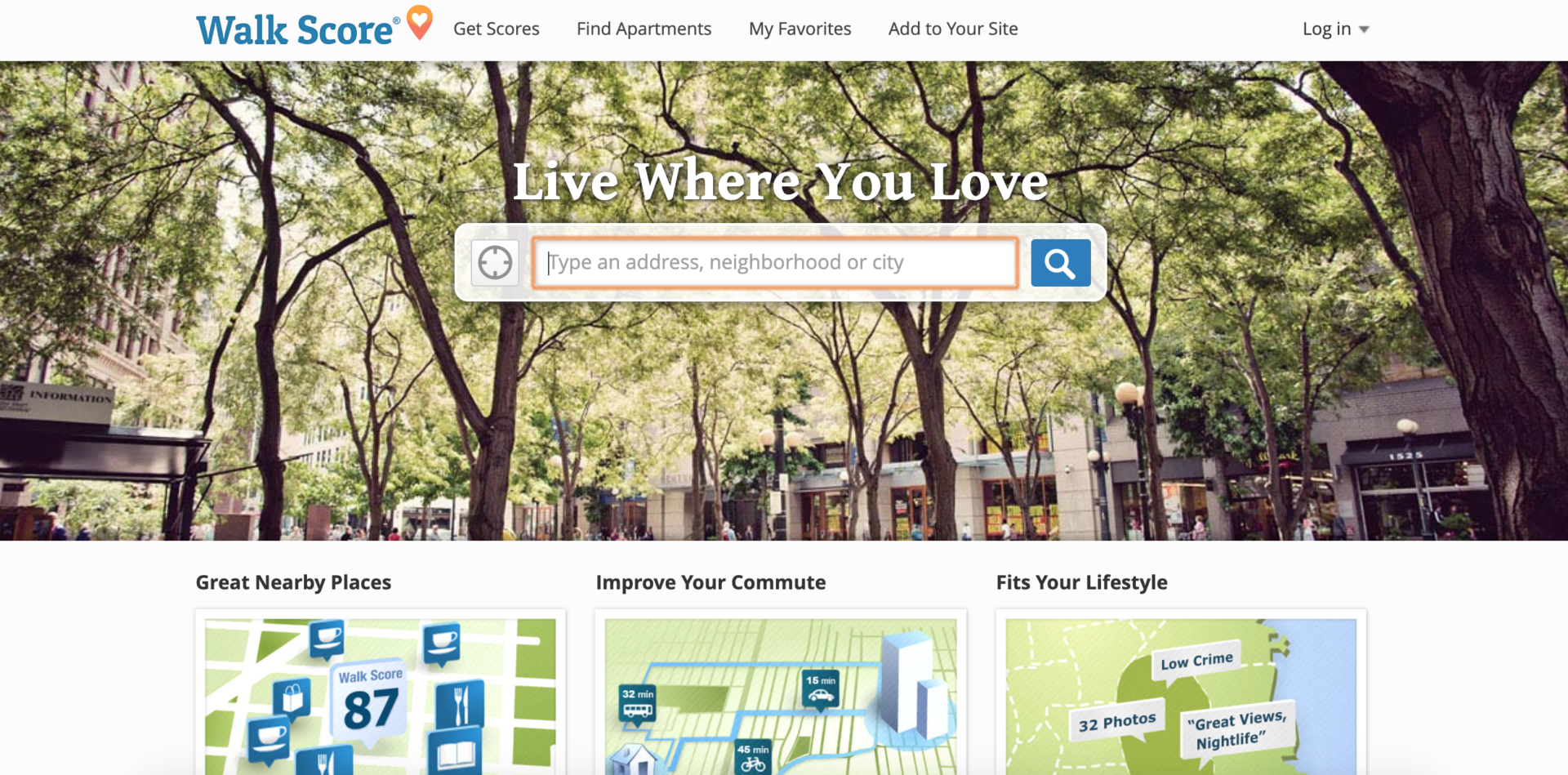
While Walk Score can help you find apartments in your area, it also provides other information that can save you money. It will give you a map of your chosen area and assign it a score based on its walkability and access to nearby grocery stores, hospitals, and parks. The map is easy to read. It highlights different areas in colors to indicate how walking-friendly or “walkable” a property is. If the map is gray, walkability is extremely poor. As walkability gets better it turns to orange, yellow, and finally green. Listings are shown as pinpoints on the map to help you identify if the property is in a walkable area you want to live in. A location with a high walkability score can help you save money on gas and transportation fees. Filters you can use to help narrow your search include:
- Price.
- Bedrooms.
- Pets allowed.
- Photos included.
- Commute to a particular address by bus, car, bicycle, or walking.
- Must-have amenities and how close of a walk you want them to be from your rental.
- Search by walk score.
- Public transit routes within a certain distance from a potential rental.
- Choosing a particular neighborhood.
Rent.com
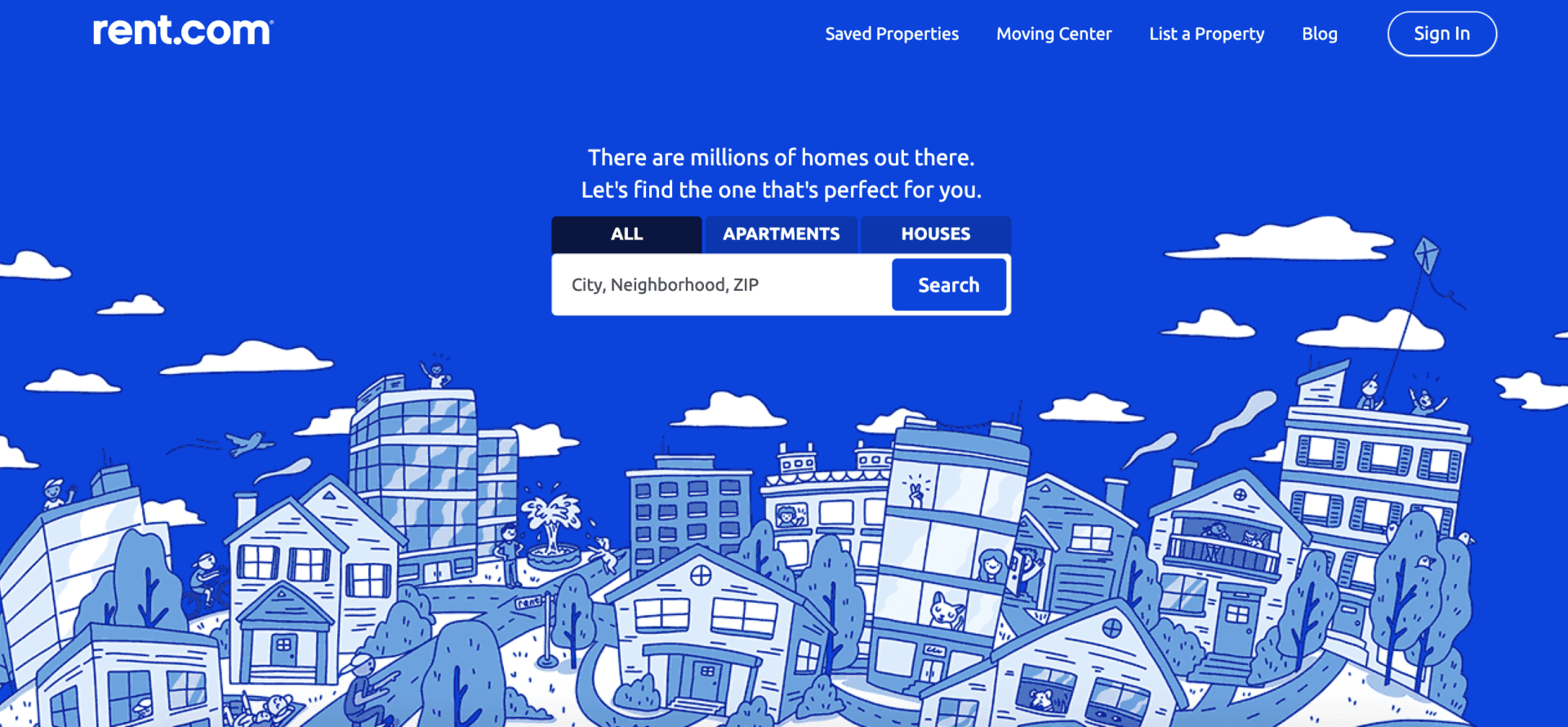
Rent.com is a comprehensive apartment website featuring complexes and private listings. It offers apartments, condos, houses, and townhouses. You can view properties using a map or by scrolling through listings. You can sort by features like:
- Price.
- Type of housing (apartment, house, etc.).
- Bedrooms and bathrooms.
- Pets allowed.
- Amenities such as appliances, air conditioning, outdoor space, controlled access, elevator, disability access, laundry, onsite personnel, pool, fitness center, laundry, and more.
- Type of community, such as senior living or income restricted.
Trulia
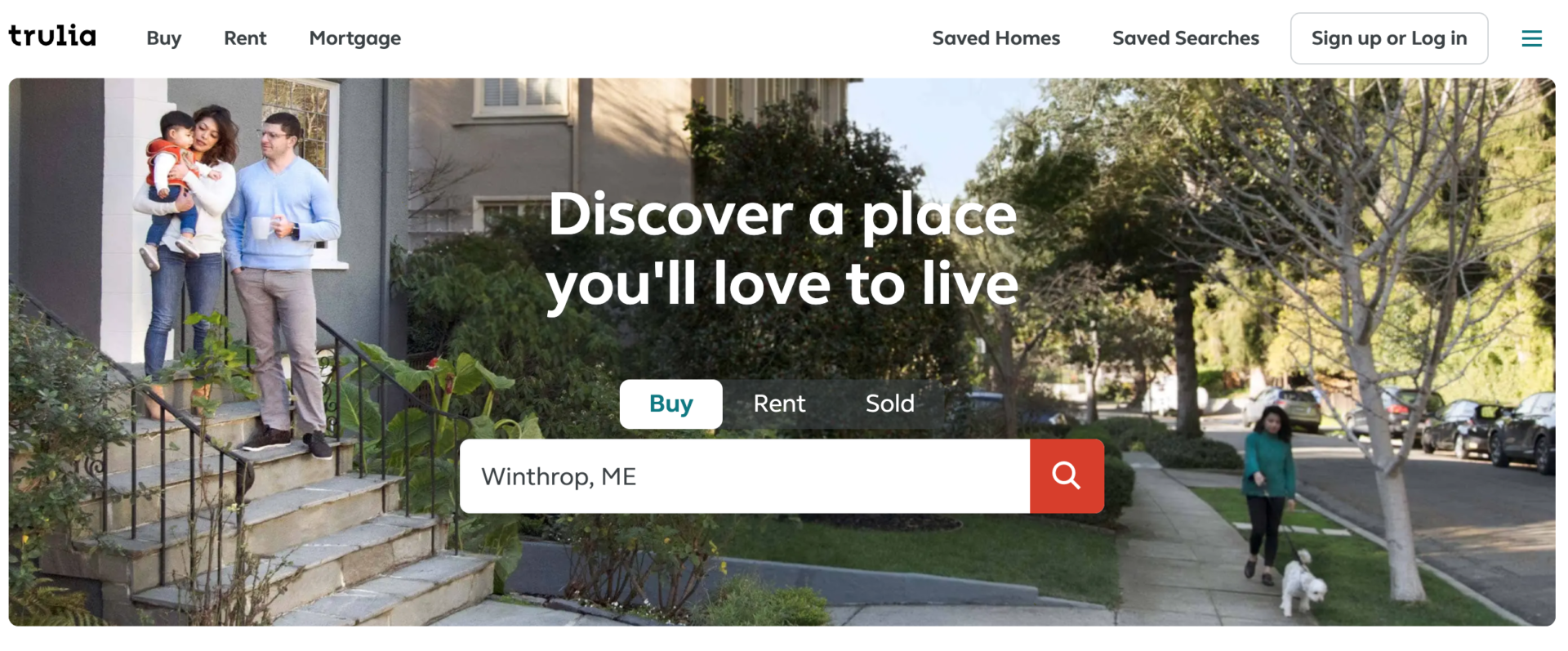 While many think of Trulia as mainly a site for buying or selling houses, it’s extremely useful for renters, too. Trulia is also one of the few sites that allows you to search by neighborhood rather than just by city. When you have a specific nook in mind, Trulia can help you find little-known opportunities you would otherwise miss. You can also save searches if you have a Trulia account. This allows you to view new listings that meet your search parameters as they pop up. Finally, Trulia offers a broad range of search and sorting options to make sure you get the rental characteristics you need including:
While many think of Trulia as mainly a site for buying or selling houses, it’s extremely useful for renters, too. Trulia is also one of the few sites that allows you to search by neighborhood rather than just by city. When you have a specific nook in mind, Trulia can help you find little-known opportunities you would otherwise miss. You can also save searches if you have a Trulia account. This allows you to view new listings that meet your search parameters as they pop up. Finally, Trulia offers a broad range of search and sorting options to make sure you get the rental characteristics you need including:
- Location.
- Price.
- Bedrooms and bathrooms.
- Square footage.
- Pets allowed.
- Rental type (condo/apartment/loft, room, townhouse, or house).
- Amenities such as laundry in the unit, air conditioning, appliances, garage, pool/hot tub, balcony, gym, and fireplace.
- Furnished housing.
- Income-restricted housing.
- Keyword search.
Apartments.com
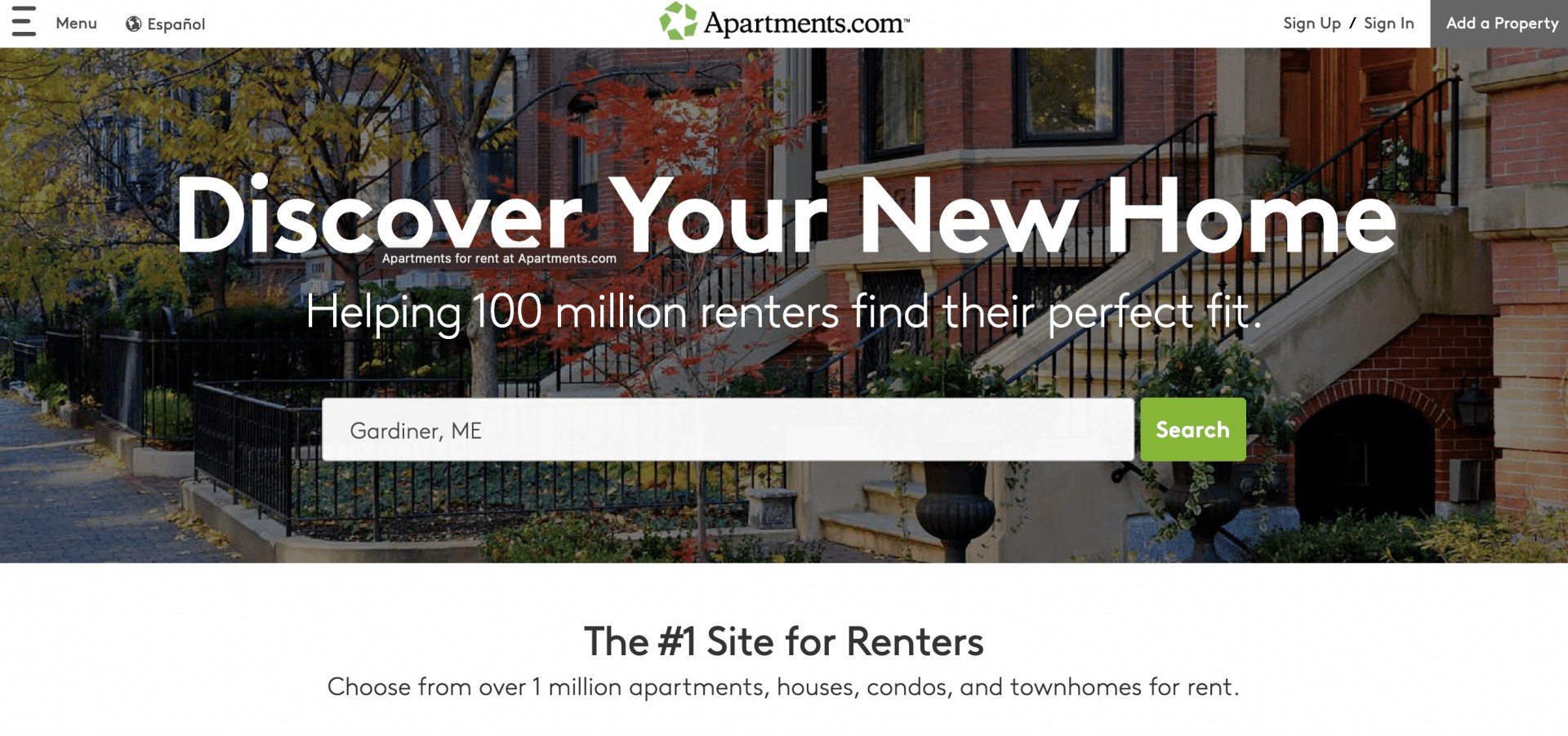 I’m betting you’ve heard of Apartments.com. I’m also betting that if you’ve ever looked for an apartment, this was one of your first stops — and there’s a very good reason for that. Apartments.com is one the best rental websites, with millions of listings. Even smaller rural towns have listings. But it’s not just the sheer number of listings that makes Apartments.com the top site for renters. The company is also committed to helping renters learn about renters’ rights and get tips to find the most affordable rentals. Of course, this site, like many of the others on this list, has tons of search options, including:
I’m betting you’ve heard of Apartments.com. I’m also betting that if you’ve ever looked for an apartment, this was one of your first stops — and there’s a very good reason for that. Apartments.com is one the best rental websites, with millions of listings. Even smaller rural towns have listings. But it’s not just the sheer number of listings that makes Apartments.com the top site for renters. The company is also committed to helping renters learn about renters’ rights and get tips to find the most affordable rentals. Of course, this site, like many of the others on this list, has tons of search options, including:
- Price.
- Number of bedrooms.
- Rental type.
- Lifestyle (student, short term).
- Move-in date.
- Amenities.
- Affordability.
- Keyword search.
Zumper

Does your work require you to frequently hop from one city to the next? If so, Zumper can help you find the right apartment for those short-term stays. Just like the other websites on this list, Zumper allows you to find different types of rental properties, including houses, studios, apartments, and condos. The difference, however, is that this site also features furnished rentals with agreements that can be renewed on a monthly basis, plus you can also look up rooms. These two features are what makes Zumper an ideal option for those who need to spend extended periods of time at a specific city for work, and aren’t looking for a long-term commitment.
Besides that, Zumper also allows you to look up long-term and vacation rentals. One of the best features of this site is that if you like a listing, you can complete the whole application process through their platform. Some of the filters Zumper features include:
- Length of rental (long term, monthly, or vacation).
- Property type (house, condo, apartment, or room).
- Number of rooms.
- Price range.
- Whether you want a pet-friendly apartment.
- Furnished or unfurnished.
- Move-in date.
Realtor.com
 You may think of Realtor.com as a website to find real estate professionals to help you purchase a house, but did you know you can look up properties for rent, too? Although most of the listings featured on this site are located in metropolitan areas, there’s no shortage of options available. So, if you’re looking for a place to rent where you can experience city life at its finest, Realtor.com has you covered.
You may think of Realtor.com as a website to find real estate professionals to help you purchase a house, but did you know you can look up properties for rent, too? Although most of the listings featured on this site are located in metropolitan areas, there’s no shortage of options available. So, if you’re looking for a place to rent where you can experience city life at its finest, Realtor.com has you covered.
The site features most types of properties, including family homes, condos, townhouses, and apartments. You can also filter properties by square footage, and limit your search by radius, so you can find a property within your desired part of the city. Other filters you can apply as part of your search include:
- Number of bedrooms.
- Number of bathrooms.
- Price range.
- Amenities (pool, gym, laundry, etc.).
- Pet-friendliness.
- Private parking spot.
- Unit features (on-site washer and dryer, waterfront, basement, and more).
HotPads

HotPads has been rising in popularity and even has its own rental search app. You can browse thousands of listings in virtually any city, town, and state across the country, and can find both affordable housing as well as luxury properties.
But the coolest thing about HotPads is that once you start your search, the website automatically populates a comparison table with up to eight properties that share similarities with the ones you’ve been eyeing. This little table tells you everything you’d like to know about each of the listings at first glance, including number of bedrooms and bathrooms, how close they are from your desired location, whether pets are allowed, and amenities included within each unit. You can also save your lists when you create an account with the website, and submit applications, for a faster process.
Another impressive aspect of HotPads is how much it allows you to refine your apartment hunt. Some of the filters you’ll find include:
- Type of property (apartment, room, sublease, or corporate).
- Location.
- Price.
- Commute distance.
- Pet-friendliness.
- Unit and community amenities (A/C, private parking, gated, doorman, etc.).
- Lifestyle (student, military, senior, and more).
Zillow
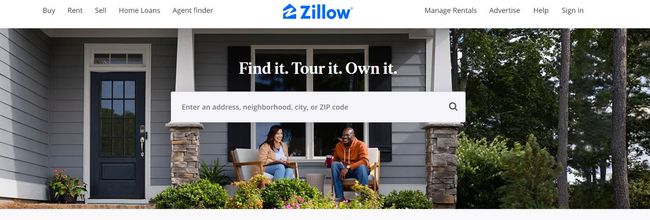
Unless you’ve been living under a rock, you’ve probably heard about Zillow. The real estate website is famous for its housing market insights, forecasts, and extensive number of listings. Although most people use Zillow to find a forever home, this site also features a rental search category.
What’s so special about Zillow — besides the overwhelming number of listings available — is that you can see the price history of a particular listing. This, in turn, can help your case when trying to negotiate an offer with the person or company that’s renting the place. Additionally, Zillow allows its users to schedule tours (both in-person and virtually) of the properties, and fill out an application online. Just like other websites on this list, Zillow allows you to refine your search by:
- Location.
- Price.
- Property type (house, condo, apartment, etc.).
- Square footage.
- Pet-friendliness.
- Number of rooms.
- Unit and community amenities (on-site laundry, A/C, parking, etc.).
- Income restrictions.
- Move-in date.
Don’t forget to get renters insurance!
No matter which website you end up using to find your next rental home, make sure you’re covered with renters insurance. Some landlords may require you to get a renters insurance policy once you rent an apartment, while others leave it up to you. Either way, it’s almost always a smart move to cover your potential liability as well as your personal belongings as a renter.
Lemonade is a company that offers renters insurance for as little as $5 per month. The company is best known for paying out claims quickly. However, what makes Lemonade truly unique is that it donates any remaining amount after claims in a given year to a cause of your choice.
» Compare quotes with the Best renters insurance companies.
Summary
Finding an affordable place is a challenging process — whether you’re looking for an apartment in New York City or a small, rural town. But online tools help you get a better sense of what’s available. By narrowing your prospects based on your needs, you’ll be able to find the perfect property in no time.


